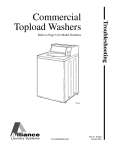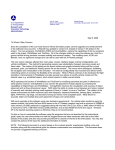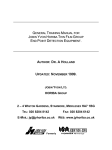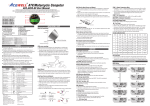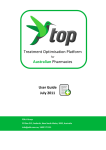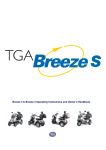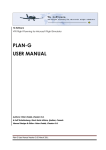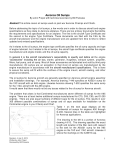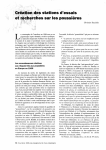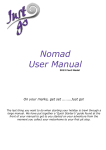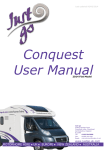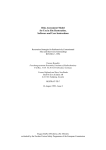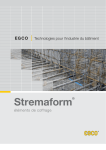Download 16 AN EXAMPLE FLIGHT PLAN in PLAN-G
Transcript
16 AN EXAMPLE FLIGHT PLAN in PLAN-G Plan-G User Manual V 3-1.061 October 2012 Page 85 to 128 from origional manual Much of Plan‐G is intuitive. You don’t need this comprehensive manual at all. So, for those who don’t have time to read manuals, but just want to get going, here is a worked example of a short VFR flight across some of England’s most beautiful and famous landscapes. It introduces as many features of Plan‐G that can be reasonably packed into a short 115 mile flight. Figure 103 Carlisle to Liverpool – The Route 16.1 Preparation Just as in the real world, there is a significant amount of preparation required before flight. Of course we will start by creating a flight plan in Plan‐G. 1. Open Plan‐G and on the Home Tab, click “Find”. 2. Select Airport from the dropdown and enter EGNC in the ICAO Code box. 3. Carlisle will be highlighted. Click OK. 4. Right‐click the airport icon and select “Start Flight Plan at airport EGNC” 5. Now set up the flight conditions. Open the Home Ribbon by clicking the Home tab, and then click Altitude, and set 4,000 feet. 6. Select Airspeed, and enter 100 knots for the default Cessna 172. 7. Now that you have a Start Location, you can now add a Start Position for your aircraft at Carlisle. In FS, you have already selected PARKING 1 ‐ RAMP GA SMALL, so from the Home Ribbon, select “Start Position”. From the options shown in the pop‐up “Set Airport Start Position” window which appears, select PARKING 1 ‐‐ RAMP GA SMALL again, and click OK. 16.2 The Scenic Route You have established the flight pre‐conditions and now it is time to plot the route to Liverpool. 1. Find the Wigton VRP to the south‐west of Carlisle. Right click and select “Add User Waypoint CARLISLE WIGTON to the plan. (Wigton is a Visual Reference Point and included in the default Plan‐G database, although it is called a User Waypoint). 2. If you do not have photographic scenery for the UK, Wigton (the town) will not be obvious, so you may wish to add a Cross Reference to it from Dean Cross VOR. Right‐click the Wigton VRP symbol and select ‘Set Waypoint Cross References’ 3. In the Cross reference window, click ‘Add’ for the first point, and enter “DCS” in the entry box. Select the Dean Cross (the only) entry, and click OK 4. Observe the Cross reference red line from Wigton to Dean Cross VOR. In the plan, note the bearing and distance (231º 8.7 nautical miles). When you fly the route, you can compare your present bearing and distance from Dean Cross VOR to find which way to fly to arrive overhead Wigton. 5. From Wigton, you will fly over Keswick and admire the beauty of the Lake District. You need to create a User Waypoint for Keswick (pronounced Kezzik, by the way). You will find Keswick to the south east of Dean Cross, on the south side of Bassenthwaite Lake and just north of Derwentwater 6. At zoom level 12, you will see the town clearly. Right click on the town name Keswick shown on the map, and complete the User Waypoint Dialogue box. Check that “Location” is set as the waypoint type. Enter Keswick Town in the Name box, and KESWIK in the Identifier box. In the tag box, you could enter your initials to indicate that it is one of your user‐created waypoints. 7. Click OK and observe the small green waypoint circle appear on the plan. If it doesn’t show, drag the map a small amount and it will be displayed as the map refreshes. 8. Now you can add another leg to the plan. Right click your new waypoint and Select the option “Add user waypoint KESWIK Keswick Town to the Plan” 9. Note that the newly added track line goes over some impressive looking high ground. It is in fact Skiddaw, at 3,052 feet, the 4 th highest mountain in England. If you have downloaded the Digital Elevation Model (DEM) tiles from the NGDC GLOBE' website at http://www.ngdc.noaa.gov/mgg/topo/gltiles.html you can now look at what this means in terms of vertical navigation. (See section 12.3 for details of DEM.) If you haven’t downloaded the DEM tile for the UK, you really ought to. It adds a great feature to Plan‐G. You need tile B, filename b10g.gz which covers 90% of the UK. 10. So you now have the DEM info installed. Open the View Ribbon, by clicking the View tab, and tick the Plan Elevation Tick box at the top left of the ribbon. 11. Whoa! That is some mountain (in UK terms anyway) 24 nautical miles en route. Note the Maximum Elevation Figure (MEF). You will now realise why the planned altitude was 4,000 feet. 12. Now zoom the map to Level 14. The names of the Lakeland peaks are visible at that scale. Move the cursor and observe the Latitude and Longitude changing on the status bar at the bottom. Find the location which is at Latitude N54º 27’ 15’’ Longitude W003º 12’ 42’’. You will see the name Scafell Pike – England’s highest mountain at 3,210ft. Create another user waypoint at the top of the mountain. Call the waypoint Scafell Pike, with the Identifier SCAFLPK. The elevation of your waypoint should be 3,100 feet. If you have the downloaded the DEM files, this value will already be set in the elevation box by Plan‐G. Figure 104 Over the Lakeland Hills 13. Add Scafell Pike to your route, as before. When you fly this route, alongside Bassenthwaite Lake, overhead Derwentwater and down the Borrowdale Valley to Scafell Pike, you will find the view hereabouts quite spectacular in default scenery, but with a good mesh and photographic scenery – simply stunning. 14. You now want to head more west to Ravenglass, Latitude N54º 24.00’ Longitude W003º 29.00’. But there are some things you need to watch out for. Open the Map ribbon, and switch on ‘RPDM Airspace’ by clicking in the tickbox. (RPDM stands for Restricted, Prohibited, Danger, Military, which could be simply translated “Don’t go there”). 15. At scale level 12, there is a large orange circle centred on Sellafield, and just south of that, a very large red fan shaped area. Open the Information Window from the View menu to see what is known about them. Click on the edge of the orange circle. In the Information Window, you will see “Restricted Area Sellafield SFC‐2200”. You cannot overfly one of Britain’s oldest and most famous Nuclear Power Stations below 2,200 feet. 16. But note also, that if you move the mouse into the open area a little to the east, the Information Window shows that you cannot fly above 5,500 feet because that is the Warton Radar Advisory Service Area.You must contact Warton Radar for permission to fly up there. (Warton is an RAF station just south east of Blackpool). 17. The big red area is Eskmeals Danger Area from the surface upwards to the stratosphere (SFC+). Eskmeals is (or was) a naval gun testing range where they fire(d) big shells out to sea. Avoid! 18. It might be a better plan to route direct from Scafell Pike to Barrow and look at nuclear submarines being built! Pan slowly down from Ravenglass and you will see Barrow (Walney Island) Aerodrome EGNL and two NDBs WL and FN. Add Barrow Aerodrome to your route. Figure 105 Sellafield and Eskmeals “Don’t Go There” Areas 16.3 A Little Stick of Blackpool Rock English comic singer George Formby made this song famous, along with his other risqué songs such as “With me little ukulele in me ‘and”. You are probably not interested in that, but to fly down the coast to Blackpool and beyond might be interesting. 1. From Barrow, looking south, you have the wide expanse of Morecambe Bay. The famous comedian Eric Morecambe took his stage name from the place. When the tide is out, this whole area is devoid of water; when the tide is in, it looks as it does in FS, all water. The area is treacherous with quicksand, very fast flowing tides and channels so that anyone caught out on the sands on an incoming tide had better get out of there quickly. It has been the scene of many tragedies. In Flight Simulator, where ditching in this dangerous area is not a consideration, you might as well plan to go straight across to Fleetwood Golf Course, a Visual Reference Point for Blackpool. Make sure you have Visual Reference Points (VRPs) enabled on the Map ribbon, so that you can see the small orange circle symbols for VRPs. Right click on the small orange circle to add Fleetwood to your route. 2. Fleetwood was once home to Britain’s second largest fishing fleet after Grimsby, but fishing has declined to near zero and the harbour today is populated by many smart yachts. If you intend to fly online and by chance Blackpool Approach is on duty, this is where you will make your initial call to them. “Request transit your Plan G User Manual V 3-1.061 October 2012 overhead at 4,000 feet”. So you had better add Blackpool EGNH to your Plan now. 3. The track line from Fleetwood to Blackpool is over land, but the “Left Hand Rule” for VFR flight states that if you are following a line feature, you should keep it on your left. This route is well used by light aircraft in the real world, who follow the convention of keeping the shoreline on the left. Thus southbound traffic flies a mile or so out to sea. Northbound traffic flies over the land. So although the trackline is over land, when you come to fly the route, you should really do the same, passing a mile or so west of the 08 end of Blackpool’s main runway. Blackpool Approach will want you to call them at the “the tall tower”. They don’t say “Blackpool Tower”, as you could well think they mean the building on the aerodrome, not the world famous 518ft high lattice steel structure a couple of miles further north. 4. After Blackpool, add Marshside VRP to your route; (you can do this now without help, surely) and then once more follow the coast to Woodvale. 5. Add Woodvale aerodrome EGOW to your plan. The airport symbol is red because it is a military (RAF in this case) aerodrome. The track line is again inland but you will want to fly on the seaward side of the shoreline. 6. So why not fly over Birkdale Sands, a beach airstrip which was first used for pleasure flights as long ago as 1919? http://www.seftoncoast.org.uk/articles/01winter_aviation.html 7. Right‐click Birkdale Sands airstrip (EGCO) to add it to your plan. The track line now goes from Marshside VRP to Woodvale then back to Birkdale Sands, a zigzag line which is not what you want. So open the Plan Window from the ‘View’ ribbon and right‐click the new Birkdale Sands entry, and select “Move waypoint up”. Now Birkdale Sands appears before Woodvale and your route is restored to something sensible. 8. Look now about 2.5 miles south of Woodvale. See the red line running horizontally across the map? Move the mouse to that line and read the information in the Information Window. Here you are at 4,000 feet. Is there something you need to do? 16.4 Controlled Airspace You are now getting close to Liverpool and things will change rapidly. You have planned to enjoy a leisurely flight with that great sense of freedom which flying (real or virtual) brings but what you will now have to plan for is controlled airspace and procedures. If you plan to fly on line, you will quite possibly have an ATC position manned – someone to talk to and give you instructions. You should be familiar with correct ATC phraseology if you are planning to fly this route on line. “Manchester TMA Class A 3500+” you should have read in the Information Window in Section 16.3, numbered item 8 above. TMA stands for “Terminal Manouevring Area, and being Class A Airspace, and you are flying VFR, you absolutely cannot go there, so you must plan to descend. About 6 miles further south again is the Liverpool Control Area (CTA) from 2500‐ 3500ft, with beneath it, the Liverpool Control Zone (CTR) which extends from the surface to 2500 feet. Both are Class D airspace. You can go there, but only with permission from Air Traffic Control. Because IFR traffic inbound to Liverpool will be brought down to a minimum altitude of 2,500 feet to capture the ILS, and required traffic separation is 1,000 feet IFR from VFR in Class D Airspace, you will be given the instruction from Liverpool Approach to fly “not above 1,500 feet.” So you must plan to descend from 4,000 to 1,500 feet in 8 miles or so, about 4 minutes. A quick calculation, tells you that that is 650 feet a minute – quite a rapid descent in a light aircraft. Figure 106 Controlled Airspace around Liverpool Figure 106 is a composite graphic showing the complexity of controlled airspace round Liverpool. Just south of Woodvale (EGOW) is the Manchester TMA boundary, and an row points to the Seaforth VRP. The other four arrows represent mouse pointer positions. The four Information Windows are shown which you will see if you place the mouse pointer at each of those positions. Of course in Plan‐G you will only see one set of information at a time in your Information Window. 9. Fortunately, all you need to know, as a light aircraft pilot inbound to Liverpool, is “Only enter the Liverpool Control Zone (CTR) at Seaforth VRP, and only then when ATC gives permission” and “Not above 1500 feet”. 10. First, however, complete the next leg of the route. 11. Find the Seaforth VRP just west of Bootle. Add Seaforth VRP to your plan. On a VFR flight, when you first contact ATC at Liverpool just after Woodvale, you will be told “Runway 27 in use, report at Seaforth, not above 1,500 feet”. 12. Now add Liverpool Airport to the plan. You now have a complete route airport to airport. 16.5 Change of Plan However, you decide to practice flying the ILS and the procedural approach (called just “the procedure” among pilots) rather than the norm of accepting vectors from Air Traffic Control, so that changes the ball game completely. You will now deemed to be flying IFR, and you need the Instrument Approach Charts, or “Approach Plates”. Plan‐ G can save you the trouble looking for those approach plates for planning as you will see. However, this manual isn’t going to tell you how to fly the procedure, but just how to complete your plan to landing. The procedure starts at the LPL NDB, so you can fly direct from Woodvale to the NDB. No need to go via Seaforth, which is the VFR route, because you are now flying IFR. 1. First, add the LPL NDB to your plan. 2. Delete the waypoint “Liverpool‐Seaforth” from your plan, by right‐clicking it’s entry and selecting “Delete Waypoint”. It is no longer relevant. Figure 107 Seaforth VRP Deleted from the Plan Figure 108 Instrument Approach Procedure 3. Right‐click on Liverpool Airport, and select “Instrument Approaches”. Select “ILS 27” from the pop‐up window. 4. Click on the transition “2. LPL” which is the one for Category A aircraft (that’s you in your Cessna), and the procedure is displayed on the map. The blue line indicates the approach path on the ILS passing over the LPL NDB. The red line is the missed approach procedure. It uses tighter radius turns and shorter distances, but is otherwise the same as 1.LPL. If you select 1.LPL temporarily you can see the difference. 16.6 VNAV Profile The next task is to create a vertical navigation profile. You need to get safely over those mountains, yet descend in time to get under the Manchester TMA near Woodvale, and then be at 2,500ft on reaching the LPL NDB. 1. Open the Plan in the Plan Window, and using the horizontal scroll bar if necessary, find the “Passing Alt” Column. It is reasonable to assume that climbing out of Carlisle at 500 feet per minute in your Cessna 172, that in the 13.9miles to Wigton, you can easily reach 2,500ft. So double click in the cell on the row CARLISLE‐WIGTON and type in 2500. 2. Move down to the Keswick row and double click the cell in the “Passing Alt” column. To make sure you clear Skiddaw and Scafell Pike, type in 4000. 3. In the same way, enter 4000 for Fleetwood Golf Course VRP and Blackpool Airport EGNH. 4. Mindful of the Manchester TMA south of Woodvale, with its base at 3500ft, go to the Woodvale row and the “Passing Alt” column, and enter 2500. 5. To fly the Liverpool 27 procedure for the ILS, you need to be at the LPL NDB at 2500 feet. So move down to the LPL row and the “Passing Alt” column, and enter 2500 again. When you fly the route, you will get “Top of Descent” alerts a mile before Woodvale, and again a mile before reaching the LPL NDB. 16.7 Notes You have read in the Flight Plans section (section 14 above) about how to enter notes. It will be important not to forget to descend below the Manchester TMA floor south of Woodvale, and to remind yourself that after Wigton, you need to be at 4,000ft. 1. Scroll across to the right of the Plan table and in the Notes column for the Keswick Row, double click and enter Continue climb to 4000ft. 2. Then do the same for the Woodvale Row, double click and enter Manchester TMA base 3500ft. Remember that passing altitudes, cross references and notes will be printed on your plog, and saved with your plan if you save the file as a .PLG file, but not if you save the file as a .PLN file. 16.8 Alternate What if you cannot land at Liverpool? What if some VATSIM or IVAO newbie is plonked right on the runway and is disinclined to move. You need to add an “Alternate” to your plan – somewhere you can go to if Newbie is still there when you are a mile from touchdown rapidly approaching the Missed Approach Point! Look around the map, and select somewhere suitable. RAF Sealand is closed, and anyway it was gliders only, Manchester won’t really welcome a slow Cessna 172, but Hawarden, just to the southwest of Chester, is G.A. friendly. Right click on Hawarden and select “Set EGNR as Alternate”. A red line is now drawn on the map from Liverpool. Hawarden (pronounced “Harden” by the way) was, in VATSIM’s early years, VATSIM UK’s busiest airport, with a controller on duty seven nights a week. Figure 109 The Track to the Selected Alternate Airport If you need an Airport diagram to find out where E_Parking 11 Ramp_GA_Medium is, (it’s an FS parking spot, so won’t be shown on the official CAA Aerodrome Diagram, will it?) right click the airport symbol once more, and select ‘Show Airport Diagram’. This opens the Airport Diagram Window and after a second or two loading the data, the airport diagram appears in the window (See Section 12.6 above for more details.) You can see the G.A. Apron with small blue circles for the parking stands. Figure 110 The Completed Plan So that is your planned flight, with some local knowledge thrown in to make it more interesting. In fact, if you don’t fly VFR often, you may have discovered that short VFR flights can be just as challenging as IFR flight across continents. When you fly the route, don’t forget to complete the task properly by taxiing to Liverpool’s General Aviation apron at the east end of the airport. Park on stand E_Parking 11 Ramp_GA_Medium, shut down and secure the aircraft. 16.9 Let’s Go Flying You have printed out the Plog from Plan‐G so it is time to go flying. 16.9.1 Microsoft Flight Simulator Figure 111 Forney Aircoupe G-ARHC Over Derwentwater in FSX 1. Open Flight Simulator, and select Free Flight from the Main Menu. 2. Set Country as United Kingdom, and select Current Location as Carlisle (EGNC). 3. Select Starting position PARKING 1 ‐‐ RAMP GA SMALL. 4. Select Aircraft type Cessna 172 5. Set a suitable time and date for a daylight VFR flight. 6. Click Fly Now. 7. When the flight has loaded, save it as the default so that you can easily get back to this position if you need to. 8. Find the current weather for Newcastle EGNX (the nearest weather station to Carlisle) from an Internet Aviation Weather site, such as http://weather.noaa.gov/weather/coded.html . 9. Set the Newcastle wind, cloud and precipitation information in FS. 10. Alternatively, if you are a member of an online Flightsim community such as VATSIM or IVAO, simply connect to the service and the weather at Newcastle will be automatically loaded into FS 11. Start up, taxi to the active and enjoy your flight over England’s highest mountains to England’s second most famous city. 16.9.2 X-Plane Figure 112 Heading towards Derwentwater in X-Plane 9 1. Start X‐Plane, and Open Settings/Quick Flight Setup 2. Set your Location as Carlisle (EGNC). 3. Select Aircraft type Cessna 172. 4. Find the current weather for Newcastle EGNX (the nearest weather station to Carlisle) from an Internet Aviation Weather site, such as http://weather.noaa.gov/weather/coded.html . 5. Set the Newcastle wind, cloud and precipitation information in the weather box. 6. Alternatively, if you are a member of an online Flightsim community such as VATSIM or IVAO, simply connect to the service with XSquawkbox or X‐IvAp and the weather at Newcastle will be automatically loaded into X‐Plane. 7. Go to Location/Local Map and move your aircraft to the main apron (if X‐Plane has placed your aircraft in the default position at the center of the runway intersections) 8. Go to Environment/Date & Time Set a suitable time and date for a daylight VFR flight. 9. Save the flight to avoid having to reset the many parameters such as QNH, and weather, and you can easily get back to this position if you need to. 10. Start up, taxi to the active and enjoy your flight over England’s highest mountains to England’s second most famous city. Note: In X‐Plane non‐hard surfaces are generally best avoided for starting up or parking, as the effect of soft ground is exaggerated.












